High-Resolution Model of Clew Bay—Model Set-Up and Validation Results
Abstract
:1. Introduction
2. Model Design, Description and Implementation
3. Results and Discussion
3.1. Validation of the Clew Bay Model against Observations
3.1.1. Validation with ADCPs
3.1.2. Validation of the Model with In-Situ Temperature and Salinity Vertical Profiles
3.1.3. Validation with Roonagh Tide Gauge Station
3.2. Clew Bay Current Patterns
3.3. Estimation of the Net Flow through Clew Bay
4. Conclusions
Author Contributions
Funding
Institutional Review Board Statement
Informed Consent Statement
Data Availability Statement
Acknowledgments
Conflicts of Interest
References
- Dúchas, E.P. A Survey of Selected Littoral and Sublittoral Sites in Clew Bay, Co.Mayo; A report prepared by Aqua-Fact International Ltd for Dúchas, Department of Arts Heritage and the Gaeltacht; Aqua-Fact International Limited: Galway, Ireland, 1999; p. 33. [Google Scholar]
- Hiscock, K. In situ survey of subtidal (epibiota) biotopes using abundance scales and check lists at exact locations (ACE surveys). In Biological Monitoring of Marine Special Areas of Conservation: A Handbook of Methods for Detecting Change Part 2. Procedural Guidelines; Hiscock, K., Ed.; Joint Nature Conservation Committee: Peterborough, UK, 1998; Version 1 of 23. [Google Scholar]
- De Grave, S.; Fazakerley, H.; Kelly, L.; Guiry, M.D.; Ryan, M.; Walshe, J. A Study of Selected Maërl Beds in Irish Waters and their Potential for Sustainable Extraction. In Marine Resource Series 10; Marine Institute: Oranmore, Galway, 2000. [Google Scholar]
- NPWS. Clew Bay Complex, (SAC Site Code: 1482). Report in National Parks and Wildlife Service, Conservation Objectives Supporting Document Marine Habitats and Species; NPWS: Dublin, Ireland, 2011; p. 2. [Google Scholar]
- Annual Aquaculture Report. A Snapshot of Ireland’s Aquaculture Sector. Statistics on Production, Price and Employment in the Primary Aquaculture Sector in 2022 Based on Our Annual National Seafood Survey of All Licensed Aquaculture Producers; BIM—Seafood Development Agency: Dublin, Ireland, 2022; pp. 49–54. Available online: https://bim.ie/publications/aquaculture (accessed on 23 December 2022).
- BIM. The Economic Contribution of the Aquaculture Sector Across Ireland’s Bay Areas. Collective Bay Report. The Economic Impact of the Aquaculture Sector Clew Bay; BIM—Seafood Development Agency: Dublin, Ireland, 2022; p. 10. Available online: https://bim.ie/wp-content/uploads/2022/05/Clew-Bay-Report-SPREADS.pdf (accessed on 23 December 2022).
- Nagy, H.; Lyons, K.; Nolan, G.; Cure, M.; Dabrowski, T. A Regional Operational Model for the North East Atlantic: Model Configuration and Validation. J. Mar. Sci. Eng. 2020, 8, 673. [Google Scholar] [CrossRef]
- Nagy, H.; Pereiro, D.; Yamanaka, T.; Cusack, C.; Nolan, G.; Tinker, J.; Dabrowski, T. The Irish Atlantic CoCliME case study configuration, validation and application of a downscaled ROMS ocean climate model off SW Ireland. Harmful Algae 2021, 107, 102053. [Google Scholar] [CrossRef]
- Dabrowski, T.; Lyons, K.; Nolan, G.; Berry, A.; Cusack, C.; Silke, J. Harmful algal bloom forecast system for SW Ireland. Part I: Description and validation of an operational forecasting model. Harmful Algae 2016, 53, 64–76. [Google Scholar] [CrossRef]
- Cure, M.; Lyons, K.; Nolan, G. Operational Forecasting in the IBIROOS Region. In Proceedings of the Adjoint Modeling and Applications, San Diego, CA, USA, 24–26 October 2005. [Google Scholar]
- Elliott, A.; Hartnett, M.; O’Riain, G.; Dollard, B. The PRISM Project: Predictive Irish Sea Models. Final Report; Catchment to Coast Research Centre University of Wales Aberystwyth and Bangor Ceredigion: Aberystwyth, UK, 2007. [Google Scholar]
- Olbert, A.I.; Dabrowski, T.; Nash, S.; Hartnett, M. Regional modelling of the 21st century climate changes in the Irish Sea. Cont. Shelf Res. 2012, 41, 48–60. [Google Scholar] [CrossRef]
- Wen, L. Three-Dimensional Hydrodynamic Modelling in Galway Bay. Ph.D. Thesis, University College Galway, Galway, Ireland, 1995. [Google Scholar]
- Ren, L.; Nash, S.; Hartnett, M. Observation and modeling of tide- and wind-induced surface currents in Galway Bay. Water Sci. Eng. 2015, 8, 345–352. [Google Scholar] [CrossRef]
- Ren, L.; Nagle, D.; Hartnett, M.; Nash, S. The Effect of Wind Forcing on Modeling Coastal Circulation at a Marine Renewable Test Site. Energies 2017, 10, 2114. [Google Scholar] [CrossRef]
- Ren, L.; Miao, J.; Li, Y.; Luo, X.; Li, J.; Hartnett, M. Estimation of Coastal Currents Using a Soft Computing Method: A Case Study in Galway Bay, Ireland. J. Mar. Sci. Eng. 2019, 7, 157. [Google Scholar] [CrossRef]
- Nagy, H.; Lyons, K.; Dabrowski, T. A Regional Operational and Storm Surge Model for the Galway Bay: Model Configuration and Validation. In Proceedings of the Ocean Sciences Meeting, San Diego, CA, USA, 16–21 February 2020. [Google Scholar] [CrossRef]
- Calvino, C.; Dabrowski, T.; Dias, F. A study of the sea level and current effects on the sea state in Galway Bay, using the numerical model COAWST. Ocean Dyn. 2022, 72, 761–774. [Google Scholar] [CrossRef]
- Calvino, C.; Dabrowski, T.; Dias, F. Current interaction in large-scale wave models with an application to Ireland. Cont. Shelf Res. 2022, 245, 104798. [Google Scholar] [CrossRef]
- Mamotous, I.; Dabrowki, T.; Lyons, K.; McCoy. A two way nested high resolution coastal simulation in a tidally dominated area: Preliminary results. In Proceedings of the 8th EuroGOOS Conference, Bergen, Norway, 3–5 October 2017. [Google Scholar]
- Shchepetkin, A.F.; McWilliams, J.C. The Regional Ocean Modeling System (ROMS): A split-explicit, free-surface, opography following coordinates ocean model. Ocean Model. 2005, 9, 347–404. [Google Scholar] [CrossRef]
- Wilkin, J.; Zhang, W.G.; Cahill, B.; Chant, R.C. Integrating coastal models and observations for studies of ocean dynamics, observing systems and forecasting. In Operational Oceanography in the Ocean forecasting in the 21st Century; Schiller, A., Brassington, G., Eds.; Springer: Dordrecht, The Netherlands, 2011; pp. 487–512. [Google Scholar]
- Sikirić, M.D.; Janekovic, L.; Kuzmic, M. A new approach to bathymetry smoothing is sigma coordinate ocean models. Ocean. Model. 2009, 29, 128–136. [Google Scholar] [CrossRef]
- Haney, R.L. On the pressure gradient force over steep bathymetry in sigma coordinates ocean models. Phys. Oceanogr. 1991, 21, 610–619. [Google Scholar] [CrossRef]
- Shapiro, R. Linear filtering. Math. Comput. 1975, 29, 1094–1097. [Google Scholar] [CrossRef]
- Warner, J.C.; Defne, Z.; Haas, K.; Arango, H.G. A wetting and drying scheme for ROMS. Comput. Geosci. 2013, 58, 54–61. [Google Scholar] [CrossRef]
- O’Dea, E.; Bell, M.J.; Coward, A.; Holt, J. Implementation and assessment of a flux limiter based wetting and drying scheme in NEMO. Ocean Model. 2020, 155, 101708. [Google Scholar] [CrossRef]
- Umlauf, L.; Burchard, H. A generic length-scale equation for geophysical turbulence models. J. Mar. Res. 2003, 61, 235–265. [Google Scholar] [CrossRef]
- Warner, J.C.; Sherwood, C.R.; Arango, H.G.; Signell, R.P. Performance of four turbulence closure models implemented using a generic length scale method. Ocean Model. 2005, 8, 81–113. [Google Scholar] [CrossRef]
- Shchepetkin, A.F.; McWilliams, J.C. Quasi-Monotone Advection Schemes Based on Explicit Locally Adaptive Dissipation. Mon. Weather Rev. 1998, 126, 1541–1580. [Google Scholar] [CrossRef]
- Smolarkiewicz, P.K.; Margolin, L.G. MPDATA: A Finite-Difference Solver for Geophysical Flows. J. Comput. Phys. 1998, 140, 459–480. [Google Scholar] [CrossRef] [Green Version]
- Arheimer, B.; Wallman, P.; Donnelly, C.; Nyström, K.; Pers, C. E-HypeWeb: Service for Water and Climate Information—And Future Hydrological Collaboration across Europe? In Environmental Software Systems. Frameworks of EEnvironment, Proceedings of the 9th IFIP WG 5.11 International Symposium, ISESS 2011, Brno, Czech Republic, 27–29 June 2011; Hřebíček, J., Schimak, G., Denzer, R., Eds.; Springer: Berlin/Heidelberg, Germany, 2011; Volume 359, pp. 657–666. [Google Scholar] [CrossRef]
- Joseph, A. Chapter 11—Vertical Profiling of Currents Using Acoustic Doppler Current Profilers. In Measuring Ocean Currents; Elsevier: Amsterdam, The Netherlands, 2014; pp. 339–379. [Google Scholar] [CrossRef]
- Fischer, J.; Visbeck, M. Deep Velocity Profiling with Self-contained ADCPs. J. Atmos. Ocean. Technol. 1993, 10, 764–773. [Google Scholar] [CrossRef]
- Comas-Rodríguez, I.; Hernández-Guerra, A.; McDonagh, E. Referencing geostrophic velocities using ADCP data Referencing geostrophic velocities using ADCP data. Sci. Mar. 2010, 74, 331–338. [Google Scholar] [CrossRef]
- Kim, D.; Yu, K. Uncertainty estimation of the ADCP velocity measurements from the moving vessel method, (I) development of the framework. KSCE J. Civ. Eng. 2010, 14, 797–801. [Google Scholar] [CrossRef]
- Pawlowicz, R.; Beardsley, B.; Lentz, S. Classical tidal harmonic analysis including error estimates in MATLAB using T_TIDE. Comput. Geosci. 2002, 28, 929–937. [Google Scholar] [CrossRef]
- Pereira, D. Wind Rose, MATLAB Central File Exchange 2023. Available online: https://www.mathworks.com/matlabcentral/fileexchange/47248-wind-rose (accessed on 31 January 2023).
- Taylor, K.E. Summarizing multiple aspects of model performance in a single diagram. J. Geophys. Res. Atmos. 2001, 106, 7183–7192. [Google Scholar] [CrossRef]
- Bernsen, E.; Dijkstra, H.A.; Wubs, F. A method to reduce the spin-up time of ocean models. Ocean Model. 2008, 20, 380–392. [Google Scholar] [CrossRef]
- Hordoir, R.; Axell, L.; Höglund, A.; Dieterich, C.; Fransner, F.; Gröger, M.; Liu, Y.; Pemberton, P.; Schimanke, S.; Andersson, H.; et al. Nemo-Nordic 1.0: A NEMO-based ocean model for the Baltic and North seas—Research and operational applications. Geosci. Model Dev. 2019, 12, 363–386. [Google Scholar] [CrossRef]
- Aijaz, S.; Ghantous, M.; Babanin, A.V.; Ginis, I.; Thomas, B.; Wake, G. Nonbreaking wave-induced mixing in upper ocean during tropical cyclones using coupled hurricane-ocean-wave modeling. J. Geophys. Res. Oceans 2017, 122, 3939–3963. [Google Scholar] [CrossRef] [Green Version]
- Dias, J.; Lopes, J. Implementation and assessment of hydrodynamic, salt and heat transport models: The case of Ria de Aveiro Lagoon (Portugal). Environ. Model. Softw. 2006, 21, 1–15. [Google Scholar] [CrossRef]
- Lopes, J.F. Using Different Classic Turbulence Closure Models to Assess Salt and Temperature Modelling in a Lagunar System: A Sensitivity Study. J. Mar. Sci. Eng. 2022, 10, 1750. [Google Scholar] [CrossRef]
- Nagy, H.; Elgindy, A.; Pinardi, N.; Zavatarelli, M.; Oddo, P. A nested pre-operational model for the Egyptian shelf zone: Model configuration and validation/calibration. Dyn. Atmos. Oceans 2017, 80, 75–96. [Google Scholar] [CrossRef]
- Mungall, J.; Matthews, J. The M2 tide of the Irish Sea: Hourly configurations of the sea surface and of the depth-mean currents. Estuar. Coast. Mar. Sci. 1978, 6, 55–74. [Google Scholar] [CrossRef]
- Robinson, I.S. The tidal dynamics of the Irish and Celtic Seas. Geophys. J. Int. 1979, 56, 159–197. [Google Scholar] [CrossRef]
- O’Rourke, F.; Boyle, F.; Reynolds, A. Tidal energy update. Appl. Energy 2009, 87, 398–409. [Google Scholar] [CrossRef]
- O’Rourke, F.; Boyle, F.; Reynolds, A. Tidal current energy resource assessment in Ireland: Current status and future update. Renew. Sustain. Energy Rev. 2010, 14, 3206–3212. [Google Scholar] [CrossRef]
- Flather, R.A.; Williams, J.A. Climate change effects on the storm surge: Methodologies and results. In Climate Scenarios for Water-Related and Coastal Impact; ECLAT-2 Workshop Report; Beersma, J., Agnew, M., Viner, D., Hulme, M., Eds.; CRU: Norwich, UK, 2000; pp. 66–78. [Google Scholar]
- Taniguchi, N.; Huang, C.; Arai, M.; Howe, B.M. Variation of Residual Current in the Seto Inland Sea Driven by Sea Level Difference Between the Bungo and Kii Channels. J. Geophys. Res. Oceans 2018, 123, 2921–2933. [Google Scholar] [CrossRef]
- Proctor, R. Tides and Residual Circulation in the Irish Sea: A Numerical Modelling Approach. Ph.D. Thesis, University of Liverpool, Liverpool, UK, 1981. Available online: https://ethos.bl.uk/OrderDetails.do?uin=uk.bl.ethos.378225 (accessed on 14 November 2022).
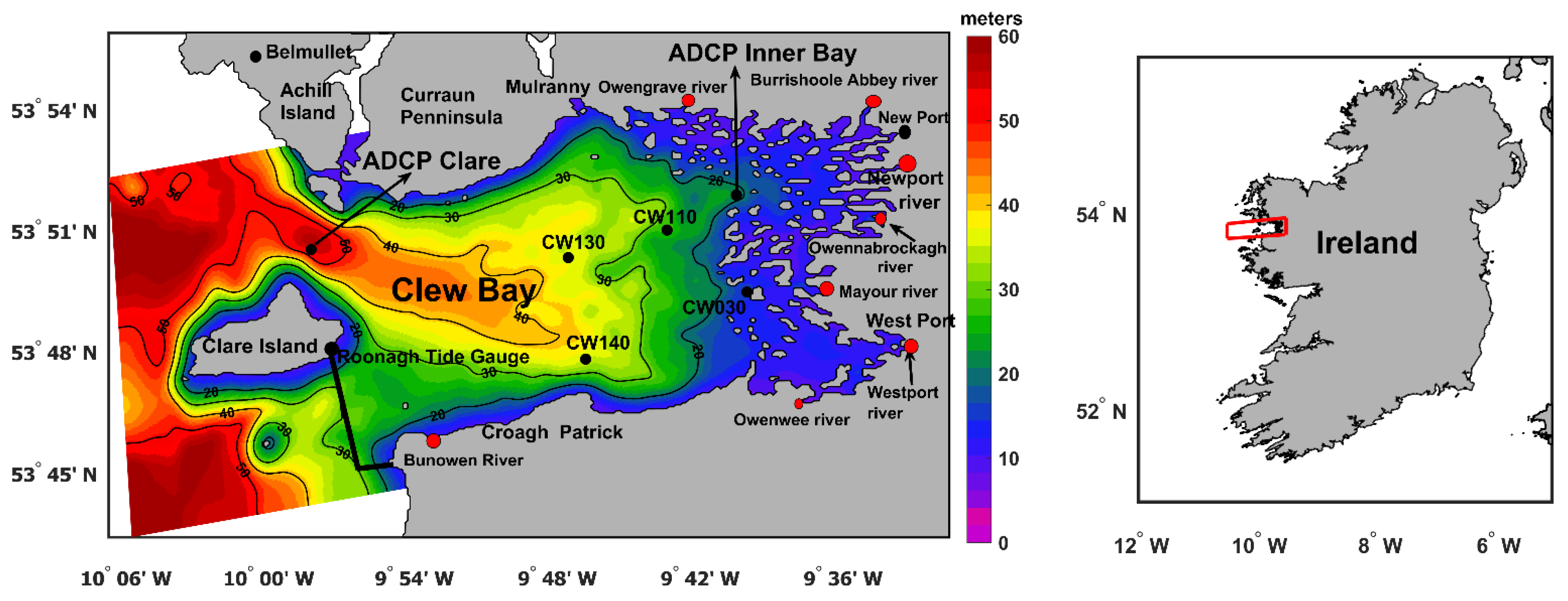
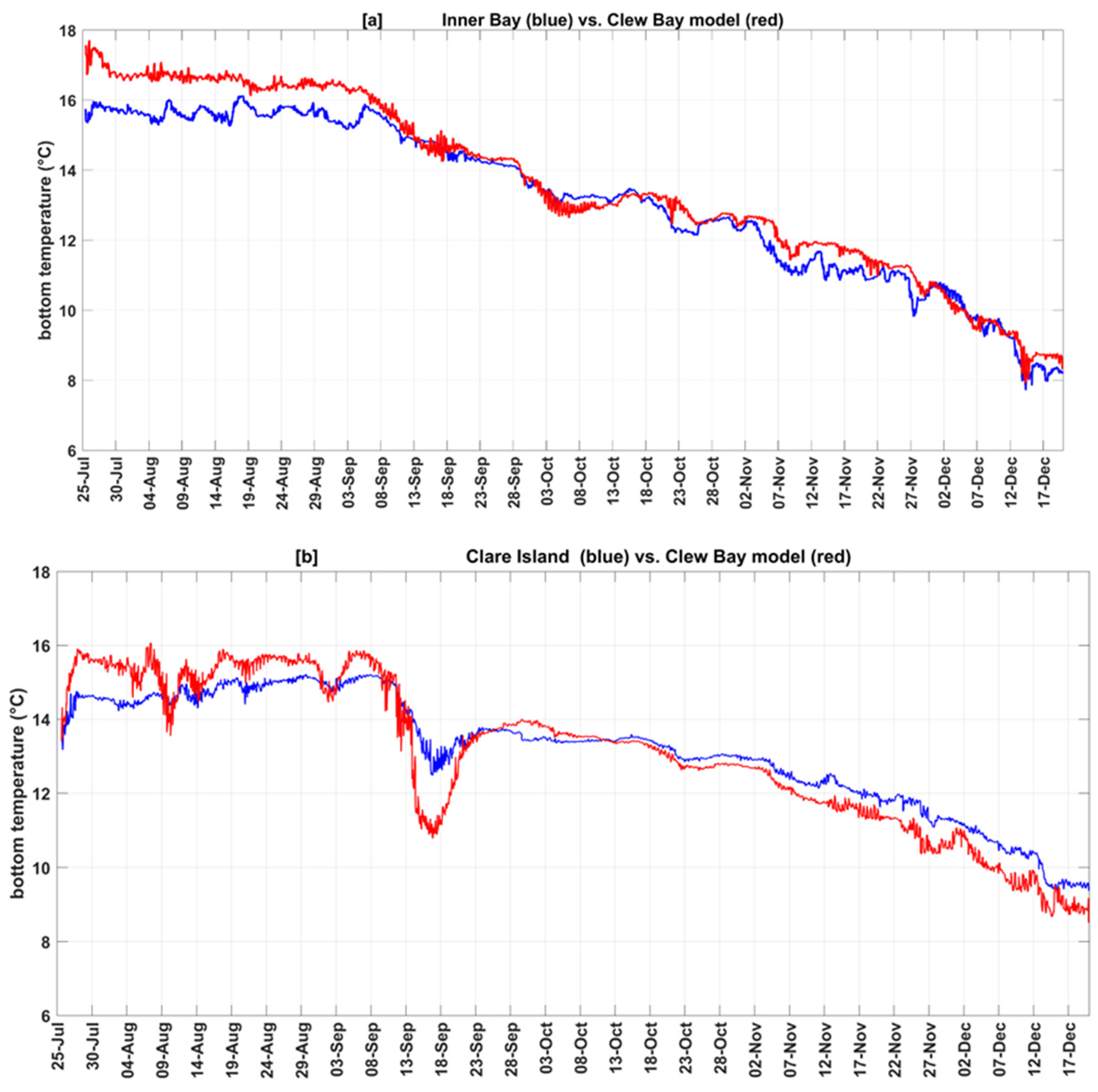
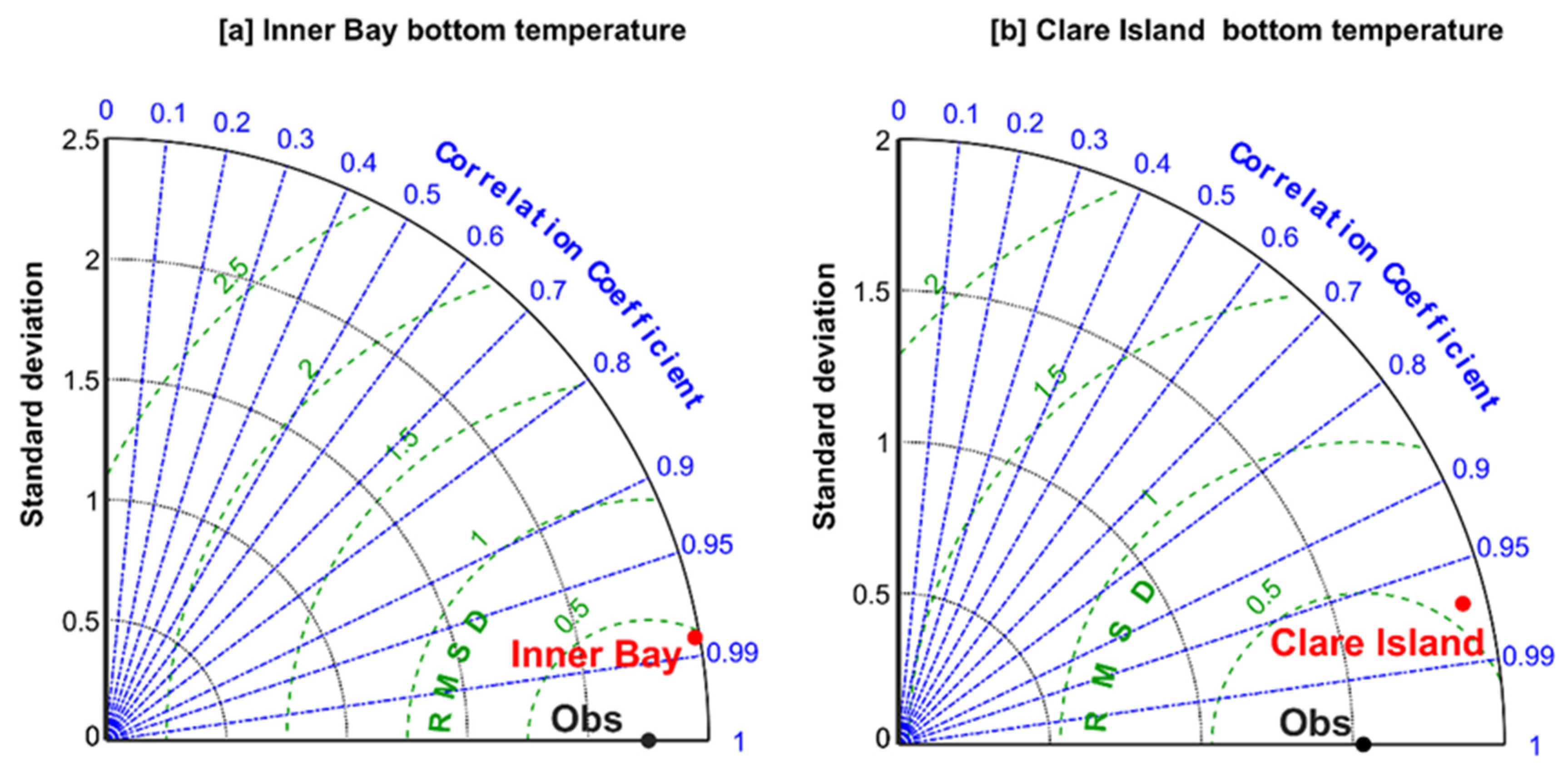
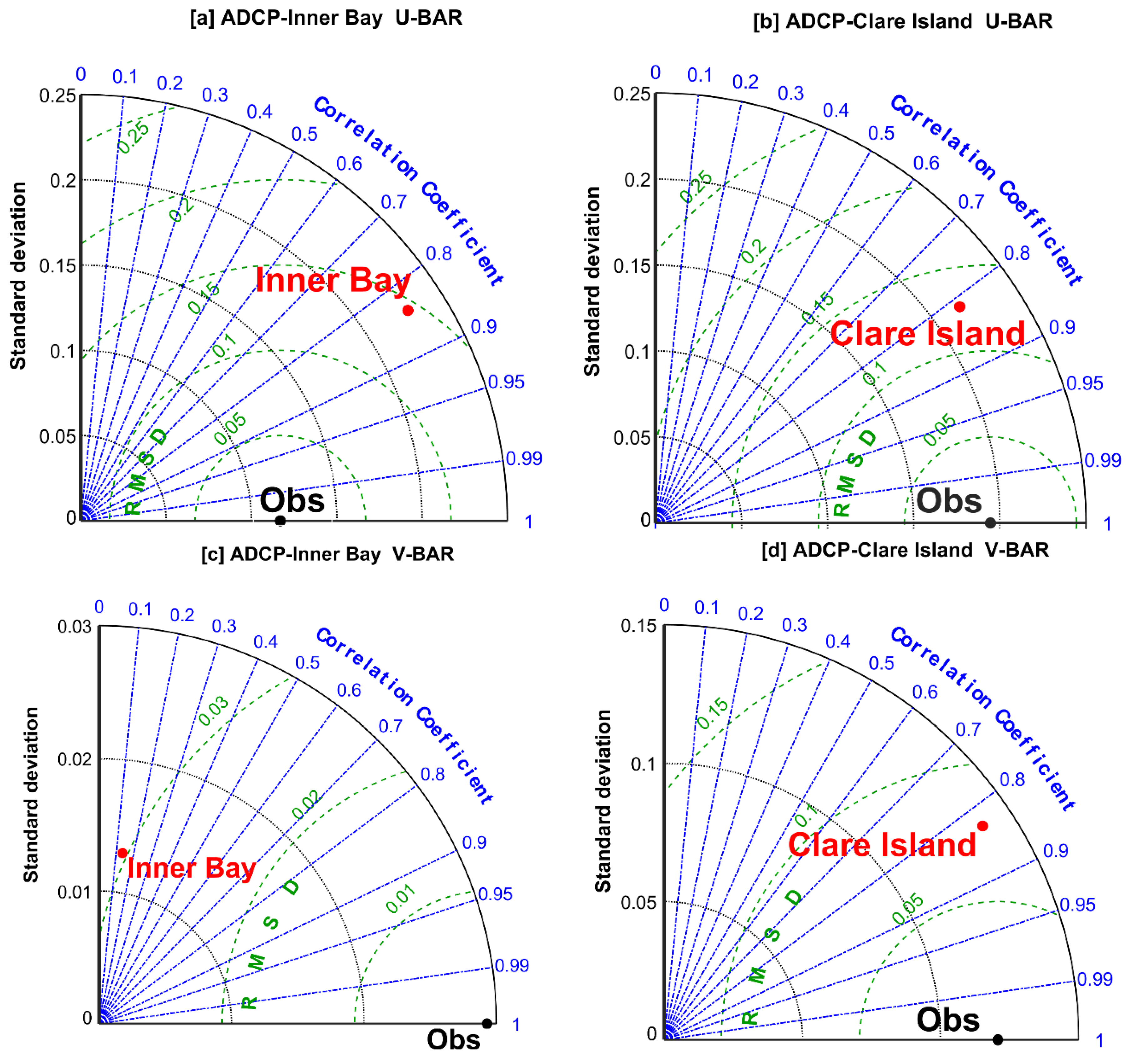

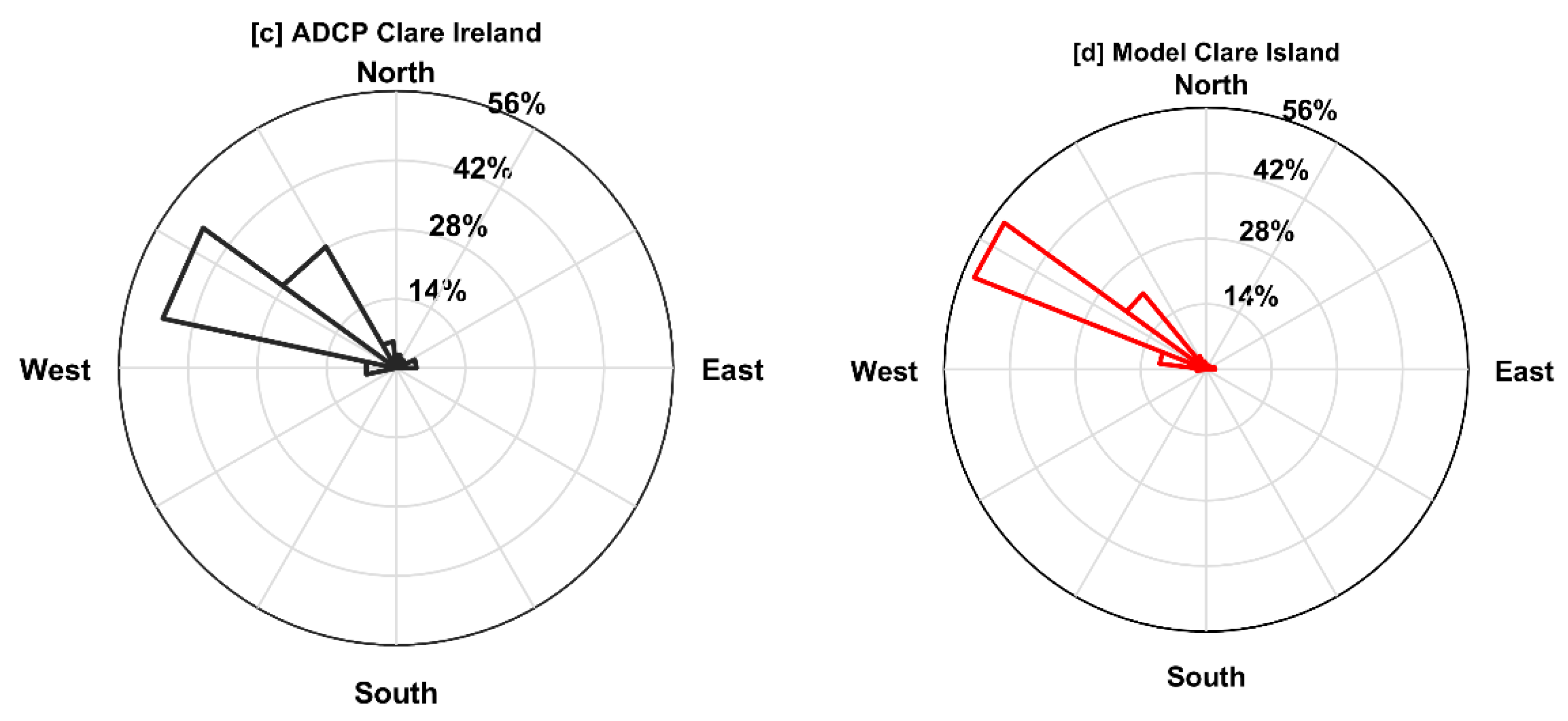
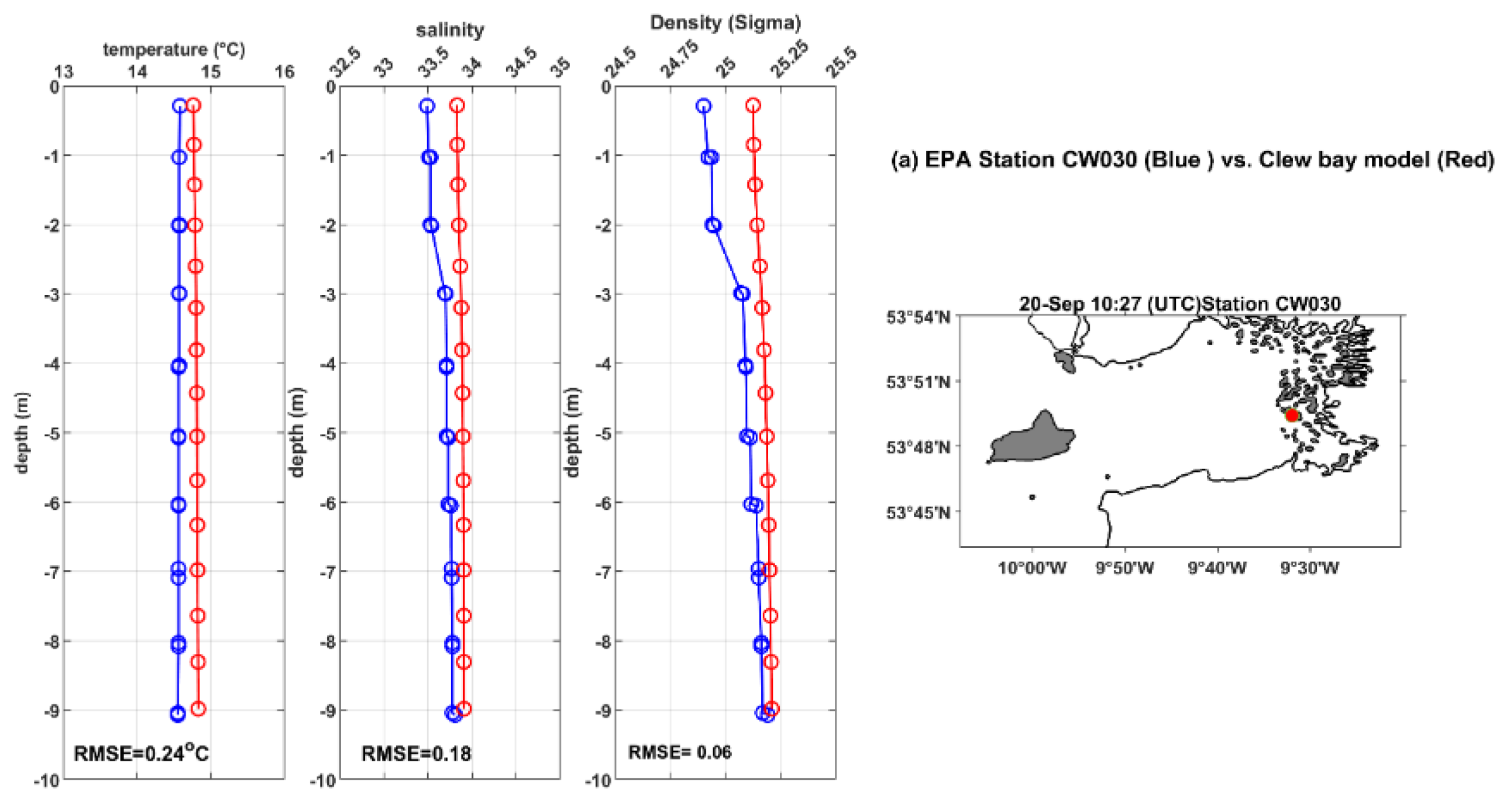

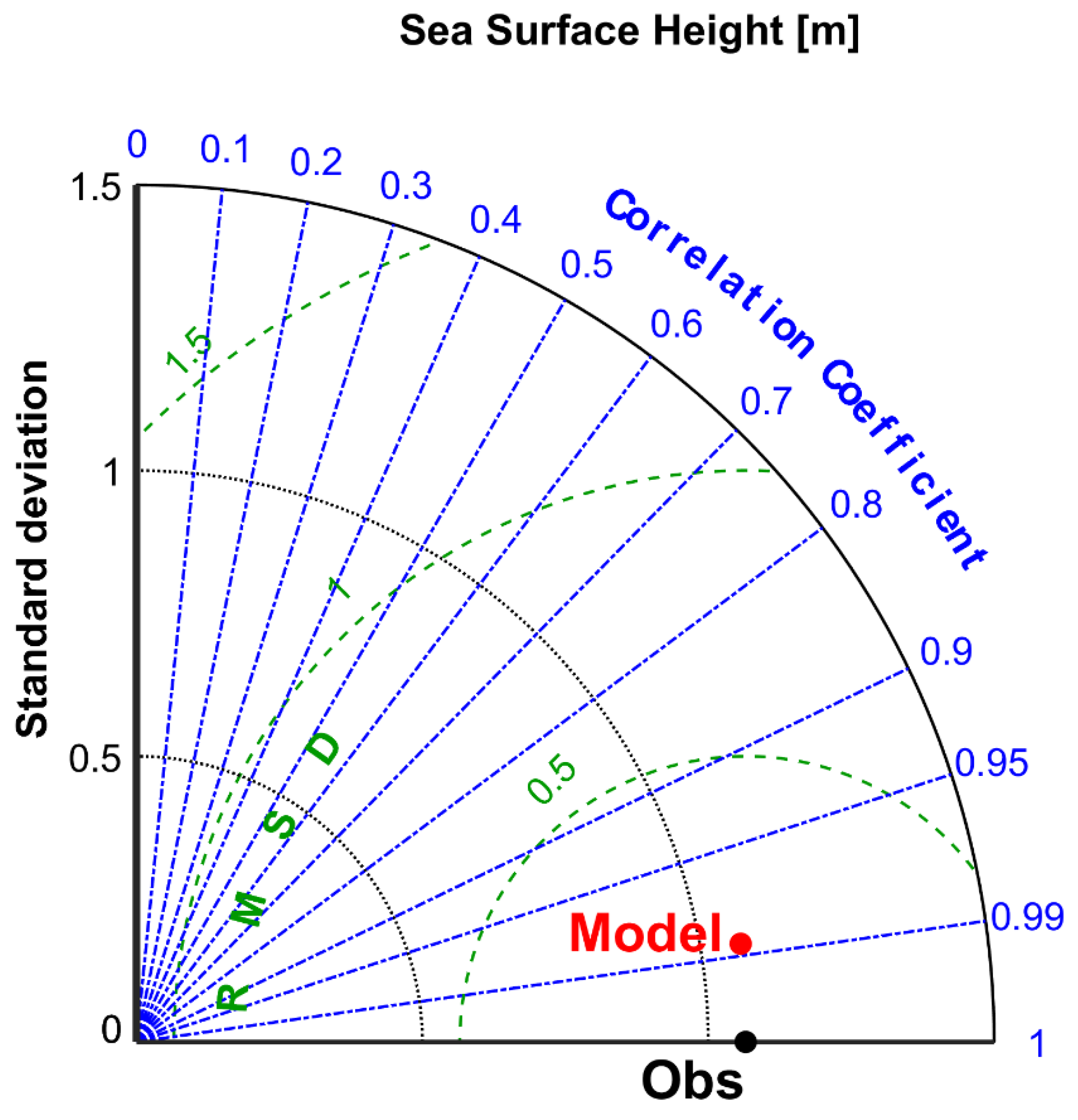
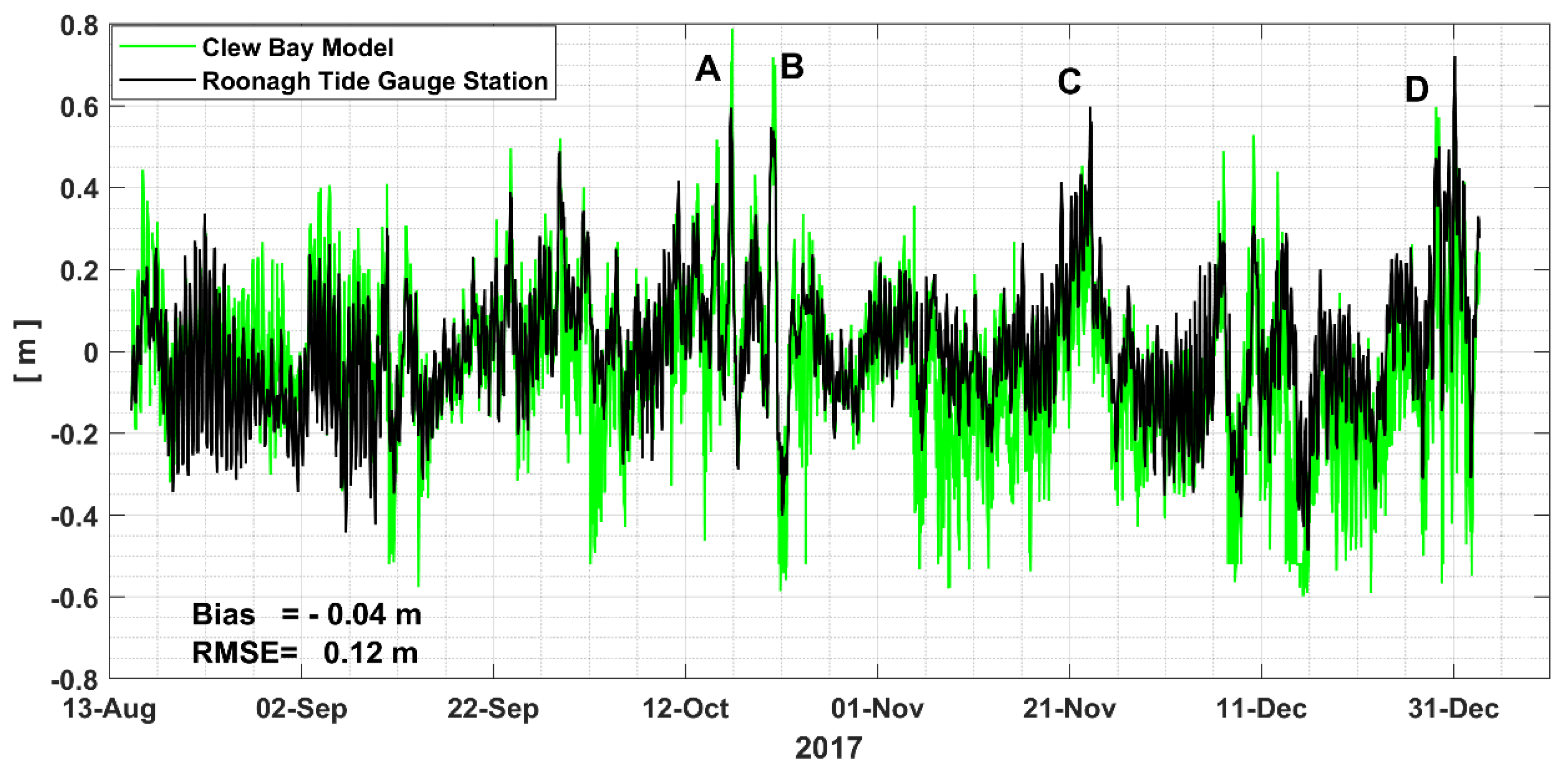
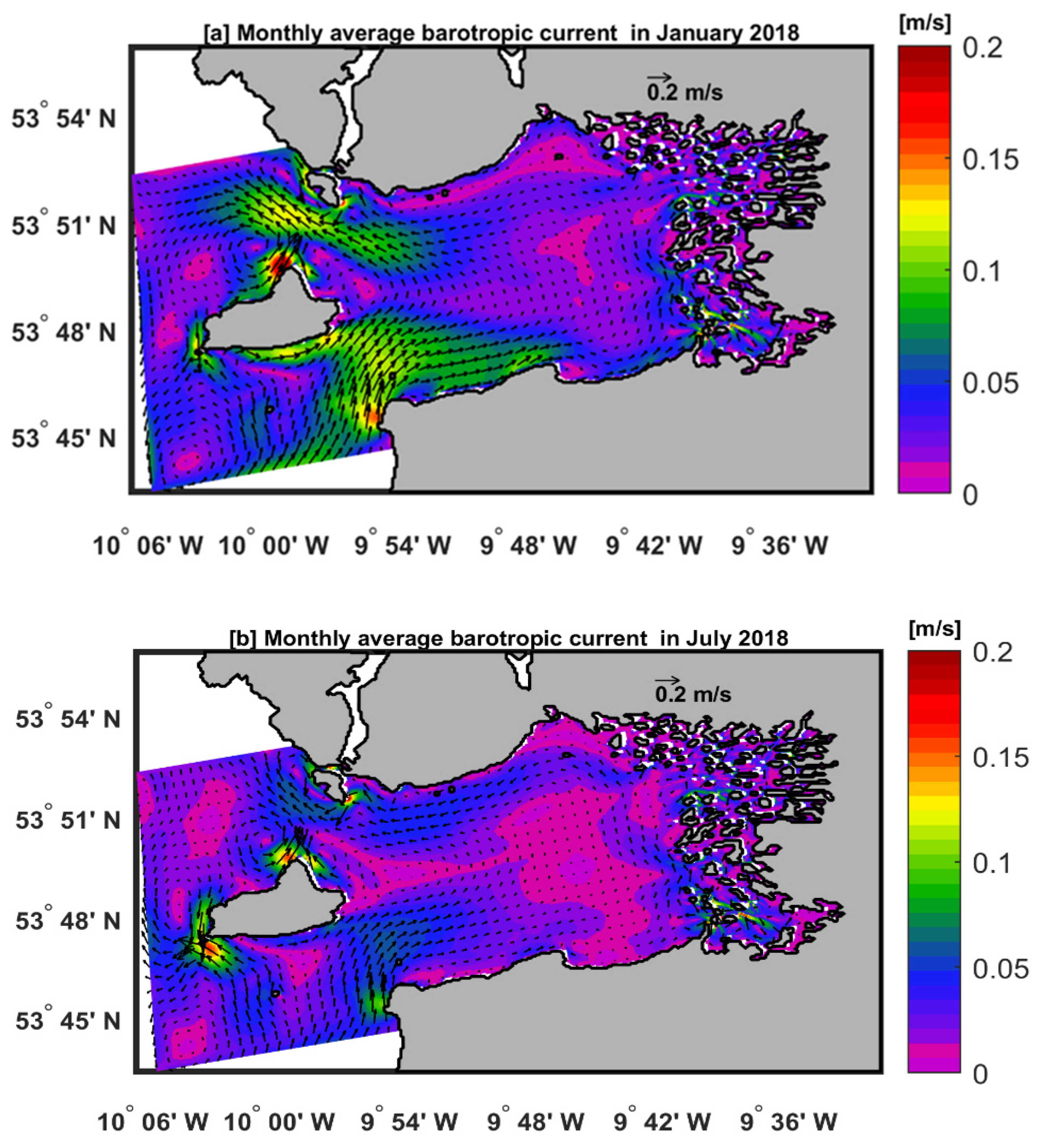
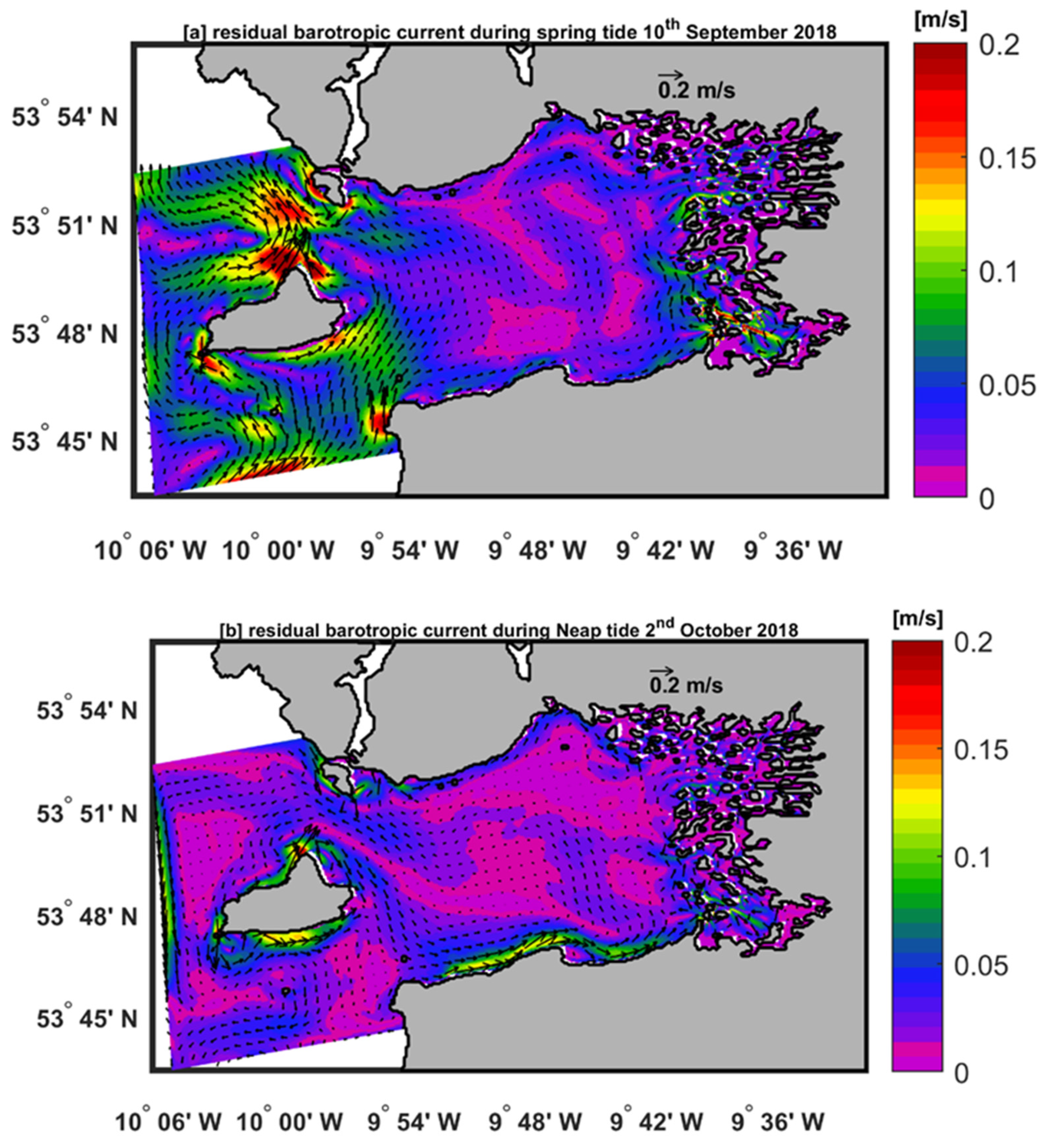
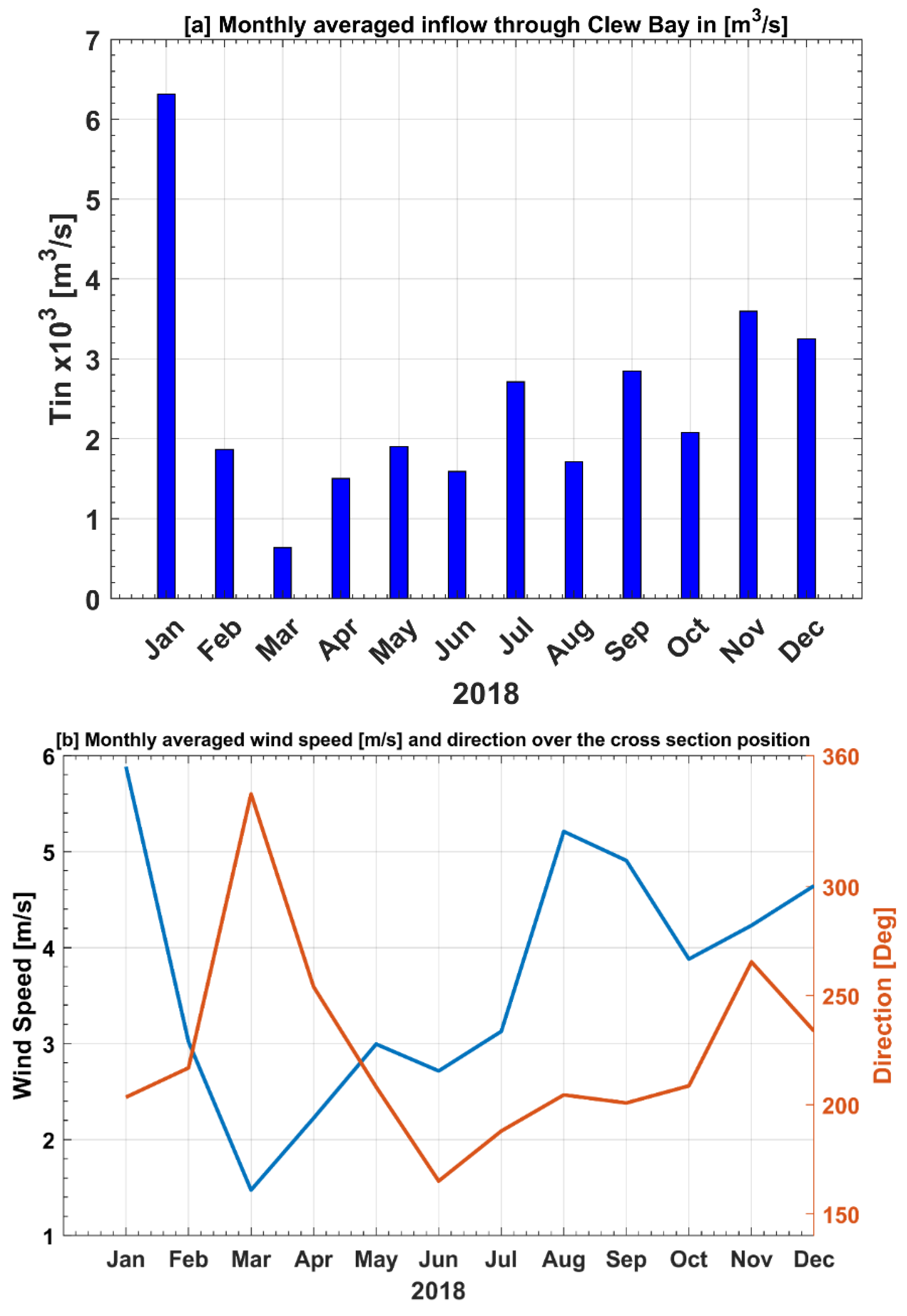

| Parameter | Definition | Value |
|---|---|---|
| GLS_P | Stability exponent (non-dimensional) | 3.0 |
| GLS_M | Turbulent kinetic energy exponent (non-dimensional). | 1.5 |
| GLS_N | Turbulent length scale exponent (non-dimensional) | −1.0 |
| GLS_Kmin | Minimum value of specific turbulent kinetic energy | 7.6 × 10−6 |
| GLS_Pmin | Minimum value of dissipation | 1.0 × 10−12 |
| GLS_CMU0 | Stability coefficient | 0.5477 |
| GLS_C1 | Shear production coefficient | 1.44 |
| GLS_C2 | Dissipation coefficient | 1.92 |
| GLS_C3M | Buoyancy production coefficient (minus) | −0.4 |
| GLS_C3P | Buoyancy production coefficient (plus) | 1.0 |
| GLS_SIGK | Constant Schmidt number (non-dimensional) for turbulent kinetic energy diffusivity | 1.0 |
| GLS_SIGP | Constant Schmidt number (non-dimensional) for turbulent generic statistical field | 1.3 |
| Region | River Name | Mean Annual Discharge [m3/s] |
|---|---|---|
| Clew Bay | Owenwee | 7.61 |
| Newport | 5.54 | |
| Bunowen | 3.17 | |
| Owengrave | 2.49 | |
| Mayour | 1.99 | |
| Westport | 1.64 | |
| Owennabrockagh | 1.98 | |
| Burrishoole Abbey | 4.98 |
| Station Name | Latitude °N | Longitude °W |
|---|---|---|
| CW030 | 53.823722 | 9.66330600000 |
| CW110 | 53.849350 | 9.71932597800 |
| CW130 | 53.837983 | 9.78848080500 |
| CW140 | 53.796000 | 9.77628176973 |
| Tidal (Main) Constituents | Model Amplitude | T.G Amplitude | Difference | Model (Phase Angle) | T.G (Phase Angle) | Difference |
|---|---|---|---|---|---|---|
| M2 | 1.360 | 1.310 | +0.050 | 180.22 | 180.65 | −0.43 |
| S2 | 0.509 | 0.508 | +0.001 | 212.62 | 210.28 | +2.34 |
| N2 | 0.278 | 0.263 | +0.015 | 158.72 | 161.72 | −3.00 |
| K1 | 0.136 | 0.135 | +0.001 | 105.27 | 96.08 | +9.19 |
| O1 | 0.073 | 0.078 | −0.005 | 329.97 | 333.08 | −3.11 |
| Q1 | 0.011 | 0.011 | 0.000 | 299.23 | 301.01 | −1.78 |
Disclaimer/Publisher’s Note: The statements, opinions and data contained in all publications are solely those of the individual author(s) and contributor(s) and not of MDPI and/or the editor(s). MDPI and/or the editor(s) disclaim responsibility for any injury to people or property resulting from any ideas, methods, instructions or products referred to in the content. |
© 2023 by the authors. Licensee MDPI, Basel, Switzerland. This article is an open access article distributed under the terms and conditions of the Creative Commons Attribution (CC BY) license (https://creativecommons.org/licenses/by/4.0/).
Share and Cite
Nagy, H.; Mamoutos, I.; Nolan, G.; Wilkes, R.; Dabrowski, T. High-Resolution Model of Clew Bay—Model Set-Up and Validation Results. J. Mar. Sci. Eng. 2023, 11, 362. https://doi.org/10.3390/jmse11020362
Nagy H, Mamoutos I, Nolan G, Wilkes R, Dabrowski T. High-Resolution Model of Clew Bay—Model Set-Up and Validation Results. Journal of Marine Science and Engineering. 2023; 11(2):362. https://doi.org/10.3390/jmse11020362
Chicago/Turabian StyleNagy, Hazem, Ioannis Mamoutos, Glenn Nolan, Robert Wilkes, and Tomasz Dabrowski. 2023. "High-Resolution Model of Clew Bay—Model Set-Up and Validation Results" Journal of Marine Science and Engineering 11, no. 2: 362. https://doi.org/10.3390/jmse11020362
APA StyleNagy, H., Mamoutos, I., Nolan, G., Wilkes, R., & Dabrowski, T. (2023). High-Resolution Model of Clew Bay—Model Set-Up and Validation Results. Journal of Marine Science and Engineering, 11(2), 362. https://doi.org/10.3390/jmse11020362








